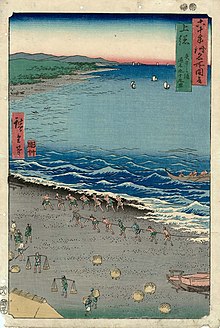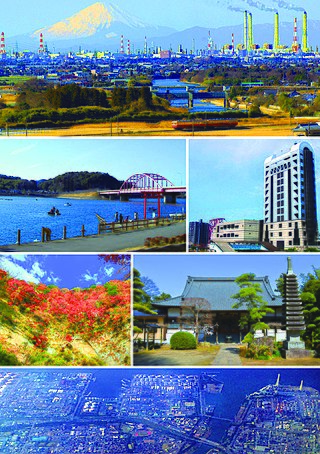
Ichihara is a city, located in Chiba Prefecture, Japan. As of 1 December 2020, the city had an estimated population of 274,117 in 128,316 households and a population density of 240 persons per km². The total area of the city is 368.20 square kilometres (142.16 sq mi). The city is home, together with the city of Chiba, to the JEF United football club. The whole city is also parts of Greater Tokyo Area.

Kimitsu is a city located in Chiba Prefecture, Japan. As of 30 November 2020, the city had an estimated population of 83,058 in 39,138 households and a population density of 260 persons per km2. The total area of the city is 318.83 km2 (123.10 sq mi).

Futtsu is a city located in Chiba Prefecture, Japan. As of 1 November 2020, the city had an estimated population of 42,476 in 18,115 households and a population density of 210 persons per km². The total area of the city is 205.53 square kilometres (79.36 sq mi).

Kōzuke Province was a province of Japan in the area of Japan that is today Gunma Prefecture. Kōzuke bordered by Echigo, Shinano, Musashi and Shimotsuke Provinces. Its abbreviated form name was Jōshū (上州). Under the Engishiki classification system, Kōzuke was ranked as one of the 13 "great countries" (大国) in terms of importance, and one of the 30 "far countries" (遠国) in terms of distance from the capital. The provincial capital is located in what is now the city of Maebashi; however, its exact location remains uncertain. The ichinomiya of the province is located in what is now the city of Tomioka.
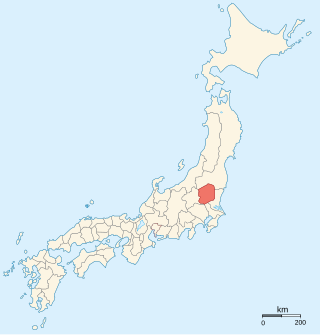
Shimotsuke Province was a province of Japan in the area of Japan that is today Tochigi Prefecture. Shimotsuke was bordered by Kōzuke, Hitachi, Mutsu and Shimōsa Provinces. Its abbreviated form name was Yashū (野州). Under the Engishiki classification system, Shimotsuke was ranked as one of the 13 "great countries" (大国) in terms of importance, and one of the 30 "far countries" (遠国) in terms of distance from the capital. The provincial capital is located in what is now the city of Tochigi. The Ichinomiya of the province is the Futarasan jinja located in what is now the city of Utsunomiya.

Sagami Province was a province of Japan located in what is today the central and western Kanagawa Prefecture. Sagami Province bordered the provinces of Izu, Musashi, and Suruga. It had access to the Pacific Ocean through Sagami Bay. However, most of the present-day cities of Yokohama and Kawasaki, now part of Kanagawa Prefecture, were not in Sagami, but rather, in Musashi Province. Its abbreviated form name was Sōshū (相州).

Tōtōmi Province was a province of Japan in the area of Japan that is today western Shizuoka Prefecture. Tōtōmi bordered on Mikawa, Suruga and Shinano Provinces. Its abbreviated form name was Enshū (遠州). The origin of its name is the old name of Lake Hamana.

Awa Province was a province of Japan in the area of modern Chiba Prefecture. It lies on the tip of the Bōsō Peninsula (房総半島), whose name takes its first kanji from the name of Awa Province and its second from Kazusa and Shimōsa Provinces. Its abbreviated form name was Bōshū (房州) or Anshū (安州). Awa Province in Shikoku phonetically has the same name, but is written with different kanji (阿波国). Awa is classified as one of the provinces of the Tōkaidō. Under the Engishiki classification system, Awa was ranked as a "middle country" (中国) and a "far country" (遠国).

Hitachi Province was an old province of Japan in the area of Ibaraki Prefecture. It was sometimes called Jōshū (常州). Hitachi Province bordered on Shimōsa, Shimotsuke, and Mutsu Provinces. Generally, its northern border was with Mutsu.
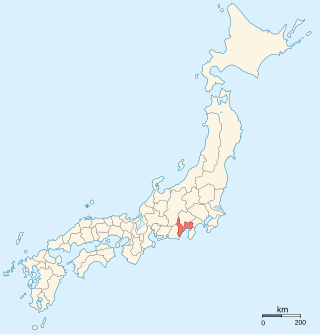
Suruga Province was an old province in the area that is today the central part of Shizuoka Prefecture. Suruga bordered on Izu, Kai, Sagami, Shinano, and Tōtōmi provinces; and was bordered by the Pacific Ocean through Suruga Bay to the south. Its abbreviated form name was Sunshū (駿州).

Shimōsa Province was a province of Japan in the area modern Chiba Prefecture, and Ibaraki Prefecture. It lies to the north of the Bōsō Peninsula (房総半島), whose name takes its first kanji from the name of Awa Province and its second from Kazusa and Shimōsa Provinces. Its abbreviated form name was Sōshū (総州) or Hokusō (北総).

Ōtaki is a town located in Chiba Prefecture, Japan. The town is known for its association with Edo period general Honda Tadakatsu, and its prominent castle. As of 1 January 2019, the town had an estimated population of 8,982 in 3820 households and a population density of 69 persons per km². The total area of the town is 129.87 square kilometres (50.14 sq mi), making it the largest of Chiba Prefecture's towns and villages.

Isumi District is a district located in Chiba, Japan. As of 2010, the district has an estimated population of 18,593 and a density of 120 persons per km2. The total area was 154.76 square kilometres (59.75 sq mi). The district formerly included all of the city of Katsuura, most of the city of Isumi and a portion of the town of Mutsuzawa. It has been reduced in size through mergers and consolidation to two towns. The district is located in the outer zone of Metropolitan Tokyo, roughly 70 kilometres (43 mi) from the center of the capital.
Kimitsu District was an administrative district in Chiba Prefecture Japan. The district was dissolved April 1, 1991 when the town of Sodegaura gained city status.
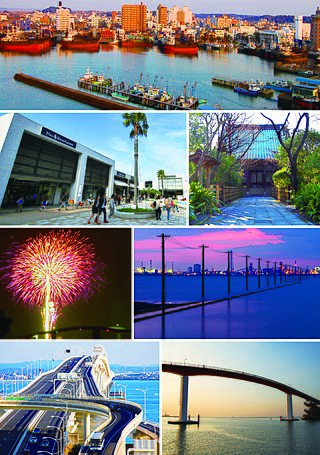
Kisarazu is a city located in Chiba Prefecture, Japan. As of 1 December 2020, the city had an estimated population of 136,023 in 63,431 households and a population density of 980 persons per km2. The total area of the city is 138.95 square kilometres (53.65 sq mi).

Tateyama Domain was a feudal domain under the Tokugawa shogunate of Edo period Japan, located in Awa Province, Japan. It was centered on Tateyama Castle in what is now the city of Tateyama, Chiba.

Kururi Domain was a feudal domain under the Tokugawa shogunate of Edo period Japan, located in Kazusa Province, Japan. It was centered on Kururi Castle in what is now the city of Kimitsu, Chiba.
Ichinomiya Domain was a feudal domain under the Tokugawa shogunate of Edo period Japan, located in Kazusa Province, Japan. It was centered on Ichinomiya jin'ya in what is now the town of Ichinomiya, Chiba.
Tsurumaki Domain was a feudal domain under the Tokugawa shogunate of the Edo period, located in Kazusa Province, Japan. It was centered on Tsurumaki jin'ya in what is now the city of Ichihara, Chiba. It was ruled for the entirety of its history by a branch of the Mizuno clan. The name of “Tsurumaki” came from the Mizuno kamiyashiki in Edo, which was located in Wadeda-Tsurumaki-cho.
Fusa Province was an ancient province of Japan, in the area of Shimōsa and Kazusa provinces. At the time of the establishment of Kazusa Province, it also included the southern tip of the Bōsō Peninsula that would later be split off as Awa Province. The ambit of this ancient entity is within Chiba Prefecture and Ibaraki Prefecture. It was sometimes called Sōshū (総州).

